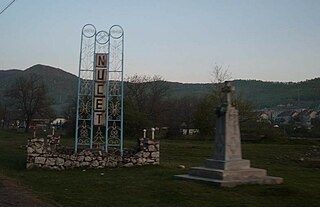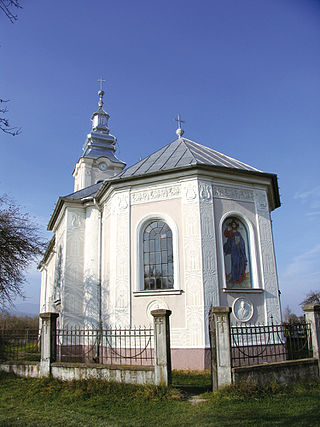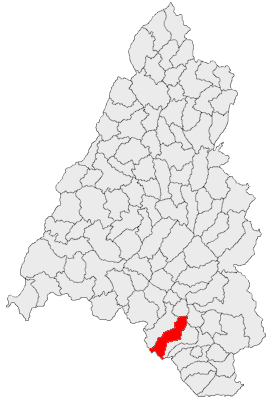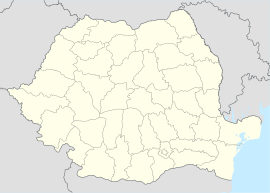
Aleșd is a town in Bihor County, western Romania. It administers three villages: Pădurea Neagră (Feketeerdő), Peștiș (Sólyomkőpestes), and Tinăud (Tinód).

Bratca is a commune situated in Bihor County, Crișana, Romania. At 5,158 (2011), it is one of the county's largest communes. It is composed of six villages: Beznea, Bratca, Damiș (Erdődámos), Lorău (Remetelórév), Ponoară (Körösponor) and Valea Crișului (Nagyfeketepatak).

Aștileu is a commune in Bihor County, Crișana, Romania. It is composed of four villages: Aștileu, Călățea (Kalota), Chistag (Keszteg), and Peștere (Körösbarlang).

Săcueni, often spelled Săcuieni, is a town in Bihor County, Crișana, Romania. It administers five villages: Cadea (Kágya), Ciocaia (Csokaly), Cubulcut (Érköbölkút), Olosig (Érolaszi), and Sânnicolau de Munte (Hegyközszentmiklós).

Nucet is a town in Bihor County, western Transylvania, Romania. Its name means "walnut trees" both in Romanian and Hungarian. It administers two villages, Băița (Rézbánya) and Băița-Plai.

Valea lui Mihai is a town in Bihor County, Crișana, Romania.

Negreni is a commune in Cluj County, Transylvania, Romania. It is composed of three villages: Bucea (Királyhágó), Negreni and Prelucele (Prelak). These were part of Ciucea Commune from 1968 to 2002, when they were split off.

Remetea is a commune in Bihor County, Crișana, Romania. It is composed of five villages: Drăgoteni (Drágota), Meziad (Mézged), Petreasa (Petrász), Remetea, and Șoimuș (Gyepüsolymos).

Roșia is a large commune in Romania, Crișana, Bihor County, around 21 kilometres north from the town of Beiuș. It is composed of two villages, Lazuri (Lázurihegy) and Roșia.

Ciuruleasa is a commune located in Alba County, Transylvania, Romania. It has a population of 1,110 as of 2021, and is composed of nine villages: Bidigești, Bodrești, Boglești, Buninginea (Buninzsina), Ciuruleasa, Ghedulești, Mătișești, Morărești, and Vulcan.

Biharia is a commune in Bihor County, Crișana, Romania. It is composed of two villages, Biharia and Cauaceu (Hegyközkovácsi).

Budureasa is a commune in Bihor County, Crișana, Romania with a population of 2,553 as of 2021. It is composed of five villages: Budureasa, Burda (Borda), Saca (Száka), Săliște de Beiuș (Belényesszeleste), and Teleac (Telek). The Stâna de Vale resort is located in the commune.

Buntești is a commune in Bihor County, Crișana, Romania with a population of 4,615 people. It is composed of nine villages: Buntești, Brădet (Biharfenyves), Dumbrăvani (Dombrovány), Ferice (Fericse), Lelești (Lelesd), Poienii de Jos (Alsópojény), Poienii de Sus (Felsőpojény), Săud (Szód), and Stâncești (Kisbékafalva).

Ciumeghiu is a commune in Bihor County, Crișana, Romania. It is composed of three villages: Boiu (Mezőbaj), Ciumeghiu, and Ghiorac (Erdőgyarak).

Drăgănești is a commune in Bihor County, Crișana, Romania. It is composed of ten villages: Belejeni (Belényeshegy), Drăgănești, Grădinari (Kisnyégerfalva), Livada Beiușului (Belényesliváda), Mizieș (Mézes), Păcălești, Păntășești (Panatasa), Sebiș (Körössebes), Talpe (Talp), and Țigăneștii de Beiuș (Cigányosd).

Lunca is a commune in Bihor County, Crișana, Romania. It is composed of six villages: Briheni (Berhény), Hotărel (Határ), Lunca, Sârbești (Szerbesd), Seghiște (Szegyesd), and Șuștiu (Susd).

Pietroasa is a commune in Bihor County, Crișana, Romania with a population of 3,209 people. It is composed of seven villages: Chișcău (Kiskoh), Cociuba Mică (Felsőkocsoba), Giulești (Zsulest), Gurani (Gurány), Măgura (Biharmagura), Moțești (Mocsest) and Pietroasa.

Tărcaia is a commune in Bihor County, Crișana, Romania with a population of 1,969 people. It is composed of four villages: Mierag (Mérág), Tărcaia, Tărcăița (Tárkányka) and Totoreni (Tatárfalva).

Uileacu de Beiuș is a commune in Bihor County, Crișana, Romania. It is composed of four villages: Forău (Belényesforró), Prisaca (Gyepüpataka), Vălanii de Beiuș (Belényesvalány), and Uileacu de Beiuș.

Vârciorog is a commune in Bihor County, Crișana, Romania. It is composed of four villages: Fâșca (Várfancsika), Surducel (Kisszurdok), Șerghiș (Serges), and Vârciorog.



























